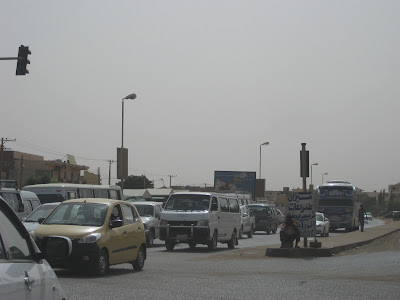By the time I had been in Khartoum for 24 hours, I'd already experienced 4 out of the 5 most common forms of public transport, and most of them I'd taken two or three times. The best form of transport, I've been told, is amjad. Amjad is a mini- minibus (about the length of a large sedan) with two rows in the back. However, it is used like a taxi, with only one set of passengers, and the drivers take you straight to your destination.
I've also taken a minibus like the ones in Malawi with 3 or 4 rows. These are called havla or hise, and they follow routes and pick up multiple passengers. The bigger buses (like inter-city buses) are just called bas, and they are nice because they are often air-conditioned. Lastly, I've taken a raksha, which is like a rickshaw.
The only other transport that I know of is a taxi. Taxis are little yellow sedans, but I've been told they are more expensive and less comfortable than amjad (which doesn't make sense to me because they are smaller).
I was shocked on my first night to discover that Sudanese drive on the right side of the road. Where does this come from? French influence??? It took me awhile to notice, too. You'd think it might have seemed strange to me that the amjad we took from the airport had it's passenger door on the right, and the driver sat on the left; or that we then drove for 20 minutes on the right side of the road. But I didn't notice until my second ride (this time on havla), when I saw another havla with a woman in the "driver's seat," and thought it was strange to have a woman driver. Then I looked around and realized we were driving on the right side.
There are also lots and lots of cars here.
Most of the main streets have quite a few lanes, and they are filled with cars, but not so much that the traffic is bad. It gives me the feeling that this is a prosperous city where most people have jobs and can afford transport, even if the distance is walkable.

I loved your posts about Khartoum. You writing is very interesting.
ReplyDeleteYour description of the people reminds me of a story about a man who was asked by a new neighbor what the people in this neighborhood were like. He asked what the people in the new person's previous neighborhood were like. "These will be the same". Most of what you see is simply a reflection of who you are.